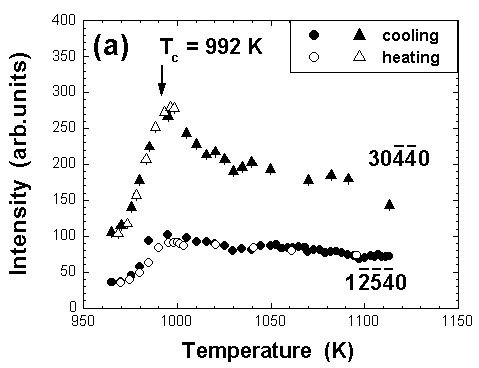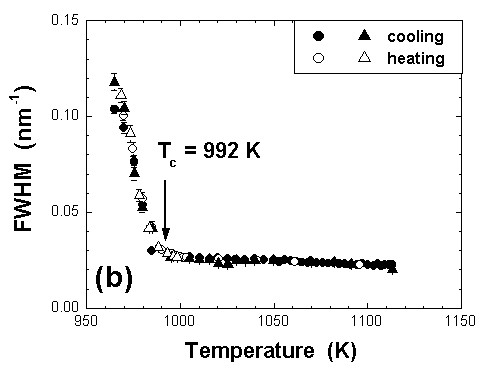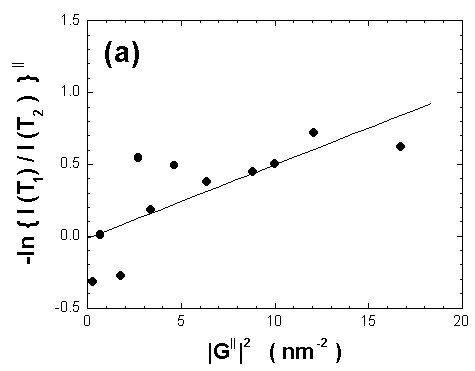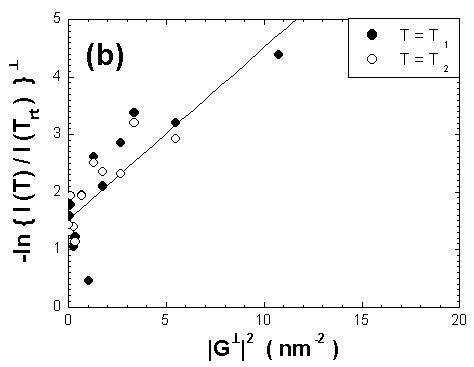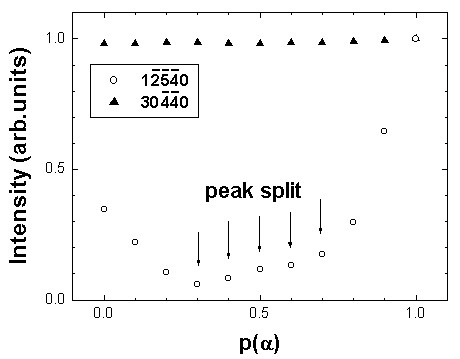Anomalous Debye-Waller Factor Associated with an Order-Disorder Transformation in an Al72Ni20Co8 Decagonal Quasicrystal
Hiroshi ABE, Hiroyuki SAITOH1, Takashi UENO1, Hironori NAKAO2, Yoshie MATSUO3, Ken-ichi OHSHIMA1 and Hitoshi MATSUMOTO
Department of Materials Science and Engineering, National Defense Academy, 1-10-20 Hashirimizu, Yokosuka 239-8686
1Institute of Materials Science, University of Tsukuba, 1-1-1 Tennoudai, Tsukuba 305-8573
2Department of Physics, Tohoku University, Sendai 980-8578
3Department of Physics, Nara Women's University, Kitauoya-Higasi, Nara 630-8506
J. Phys. Soc. Jpn. 72, 1828 (2003).
Abstract
An order-disorder transformation in a single decagonal quasicrystal of
Al72Ni20Co8
is
studied in detail. In X-ray diffraction, the anomalous attenuation of
intensities
of Bragg reflections was found around the transformation temperature, Tc. The intensity attenuation at high temperature is explained by the anomalous
Debye-Waller factor in thermal lattice dynamics. In particular, the intensity
ratio above Tc and below Tc depends on |Gperp|2 values. In addition, the intensity ratio between room temperature and
high temperature shows |Gperp|2 dependence. The results correspond to the in situ observation of a local
vibrational anomaly related to an atomic flip by electron microscopy (Abe
et al.: Nature 421 (2003) 347.). By X-ray diffraction, dynamic fluctuations as observed
in electron microscopy are also realized even on a macroscopic scale at
high temperature.
KEYWORDS: quasicrystal, phason, atomic flip, order-disorder transformation, Debye-Waller factor
|
|
Fig. 1 Temperature dependences of (a) the intensities and (b) FWHM for the 30440 and 12540 Bragg reflections. The intensities of the Bragg reflections are almost reversible. Anomalous decreases of Bragg intensities were seen below Tc. At the same time, peak broadening occurred. |
|
|
Fig. 2 (a)|Gpara|2 dependence of the intensity ratio of Bragg reflections at 965 K (=T1<Tc) and 1096 K (=T2>Tc). (b) |Gperp|2 dependence of the intensity ratio between room temperature (Trt) and high temperature. |
|
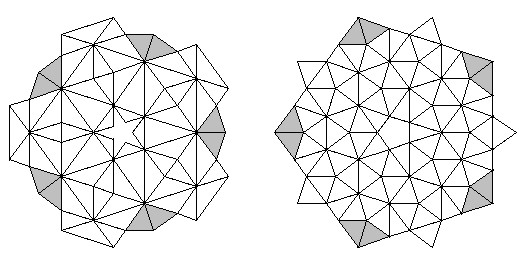 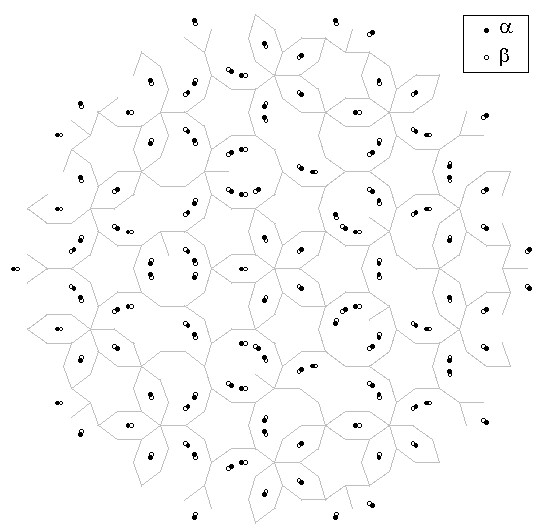 |
Figure 3 (a) Occupation of domains of (1/5 1/5 1/5 1/5 1/4) (left) and (2/5 2/5 2/5 2/5 1/4) (right). (b) Preoccupation domains of ¿ and Àgenerate phason-related atomic positions. The distance between them is 0.095 nm. The lines indicate the HBS tiling with an edge length of 0.636 nm. |
|
|
Fig. 4 Calculated intensities of the 12540 and 30440 Bragg reflections without the Debye-Waller factor. p(¿) is the occupation probability of Al on ¿-sites. |
References
1) S. Ritsch, C. Beeli, H. –U. Nissen, T. Godecke, M. Scheffer and R. Luck: Philos. Mag. Lett. 74 (1996) 99.
2) A. P. Tsai, A. Fujiwara, A. Inoue and T. Masumoto: Philos. Mag. Lett. 74 (1996) 233.
3) K. Saitoh, K. Tsuda, M. Tanaka, K. Kaneko and A. P. Tsai: Jpn. J. Appl. Phys. 36 (1997) L1404.
4) E. Abe, K. Saitoh, H. Takakura, A. P. Tsai, P. J. Steinhardt and H. –C. Jeong: Phys. Rev. Lett. 84 (2000) 4609.
5) H. Takakura, A. Yamamoto and A. P. Tsai: Acta Crystallogr. Sect. A57 (2001) 576.
6) K. Edagawa, H. Sawa and S. Takeuchi: Philos. Mag. Lett. 69 (1994) 227.
9) T. C. Lubensky, J. E. S. Socolar, P. J. Steinhardt, P. A. Bancel and P. A. Heiney: Phys. Rev. Lett. 57 (1986) 1440.
10) K. Edagawa, K. Suzuki and S. Terauchi: Phys. Rev. Lett. 85 (2000) 1674.
11) E. Abe, S. J. Pennycook and A. P. Tsai: Nature 421 (2003) 347.
12) P. A. Bancel: Phys. Rev. Lett. 63 (1989) 2741.
13) Y. Ishii: Mater. Sci. Eng. 294-296 (2000) 377.
14) M. A. Chernikov, H. R. Ott, A. Bianchi, A. Migliori and T. W. Darling: Phys. Rev. Lett. 80 (1998) 321.
15) C. L. Henley, M. Mihalkovic and M. Widom: J. Alloys Comp. 342 (2002) 221.
16) H. Abe, N. Tamura, D. Le Bollocfh, S. C. Moss, Y. Matsuo, Y. Ishii and J. Bai: Mater. Sci. Eng. A 294-296 (2000) 299.
National Defense Academy
Last Modified: April 1, 2009
